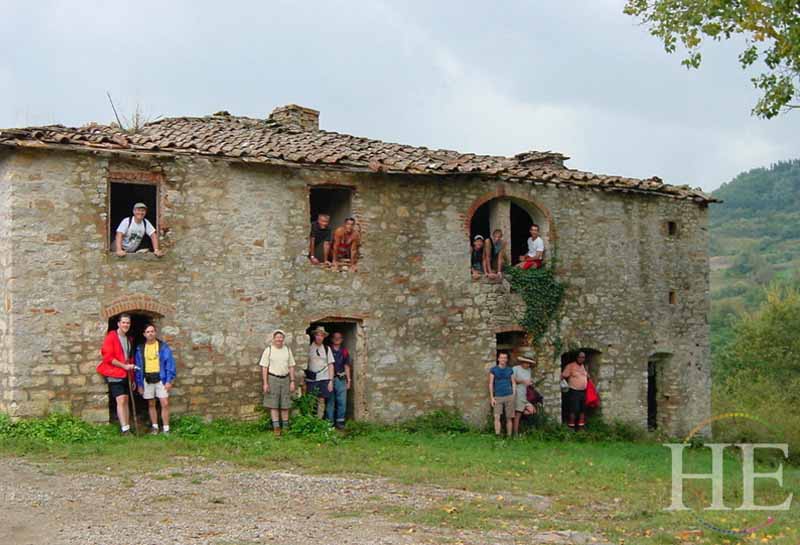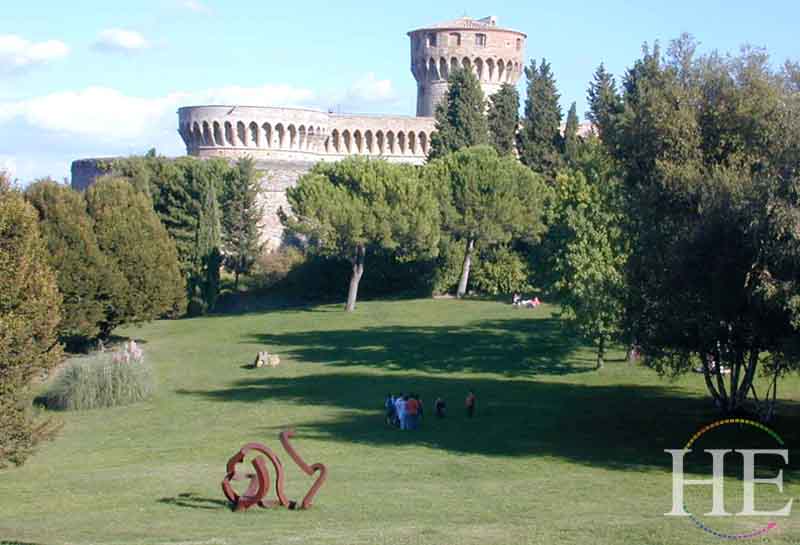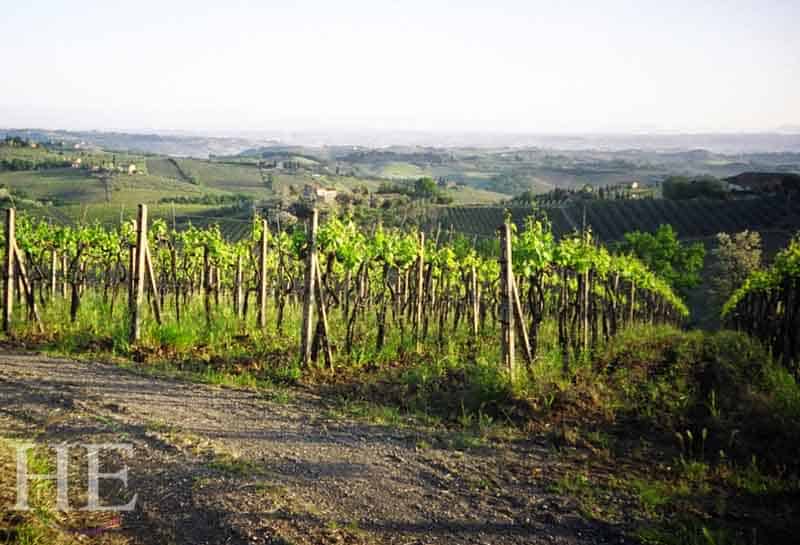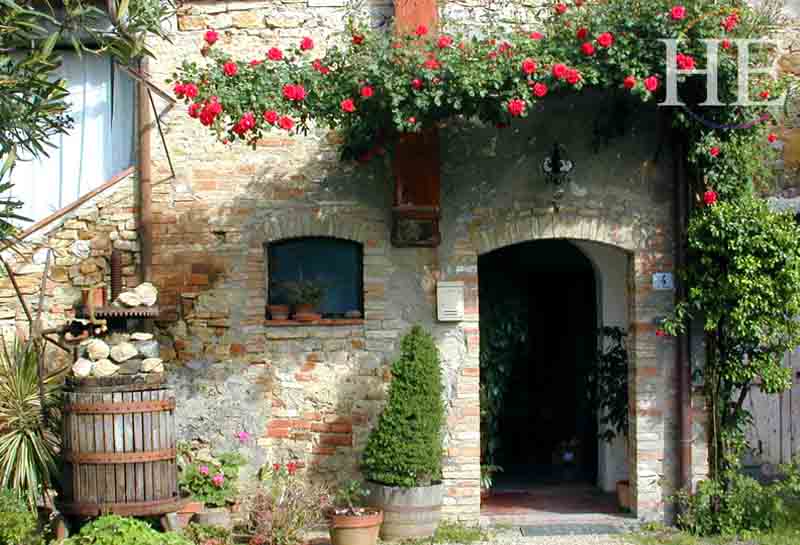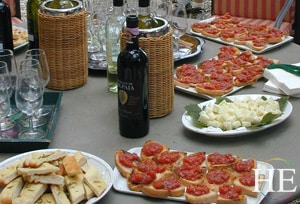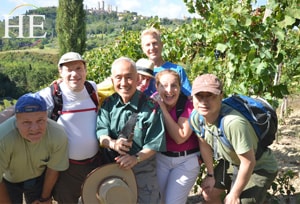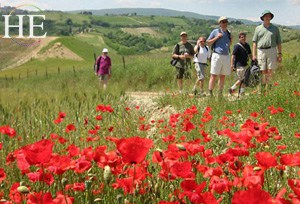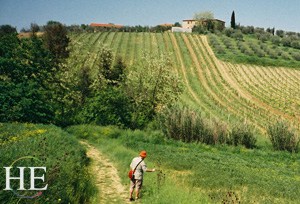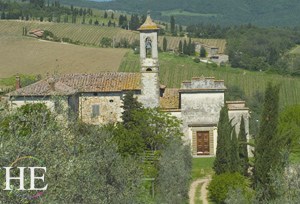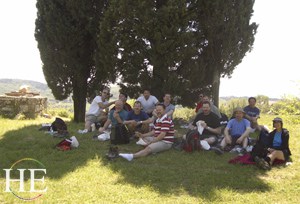Tuscan Trails Gay Travel Italy Hiking Tour
A Gay Travel Italian Hiking Tour in Tuscany
Prices listed are per person:
Shared Room: $TBA
Private Room: $TBA
Enjoy a week of fun on this gay hiking tour in Italy. See Florence and the fairy-tale village of San Gimignano. Trek through orchards, vineyards, and woodland on our way to Radda to visit ancient stone villages, churches, farms, and Etruscan bridges, arches and burial mounds.
Highlights
Start your exploration of Tuscany with one night in Florence, including dinner and an informal walking tour of the city’s monuments the next morning;
Lose yourself in the narrow, ancient streets of San Gimignano, with its turreted, 12th-century skyline;
Walk through Etruscan burial mounds dating to 700 B.C.;
Visit a working Tuscan farm and a Chianti winery;
Climb through the isolated ruins of Castelvecchio, once a thriving castle and community, now reduced to a sprawl of overgrown walls and crumbling towers;
Sample gelato at the ancient hilltop town of Volterra;
Discover the foods of Tuscany: thick vegetable soups; tangy cheeses; hearty dishes of wild boar; and delicate varieties of truffles and mushrooms.
Overview
A gay hiking trek through verdant forests and orchards, with an appetite for Italy’s famous cuisine
Our hiking week in Italy begins with a night in Florence, complete with dinner and an informal walking tour of the city, then four nights in the fairy-tale village of San Gimignano, a perfectly preserved Renaissance town perched on a hill here in Tuscany. You’ll want to spend some time right in town, exploring the 12th-century cathedral and the Devil’s Tower. Then we head out for walks and day hikes. Trek through a patchwork of orchards, vineyards, and woodland, keeping your eyes open for porcupines, pheasants, and wild boar.
The last three nights of our trip are in the Italian hilltown of Radda. Despite its location in the heart of “Chianti Classico” wine country, the rugged terrain around Radda is surprisingly wooded. Our daily hikes take us to ancient stone villages, churches, and farms, as well as Etruscan bridges, arches and burial mounds built in 700 B.C. Follow quiet tracks and roads over rolling hills, through forests, fields of wildflowers, and fragrant vineyards, working up an appetite for a hearty Tuscan meal.
As on our bike trips, this hiking and walking week is designed to allow you to find a comfortable blend of group activity and independent hiking. Our coordinator will go out with a group each day; you’re invited to walk with this group or to hike independently with one or two new friends.
Itinerary
Map:
Being part of a small, friendly gay and lesbian group means you’ll feel immediately at home here in Tuscany. The itinerary below relates a typical week, and largely reflects the trails we followed on several of our past trips. However, accommodations occasionally vary, and our actual sequence of hikes may change based on weather and other conditions. And, of course, you always have the choice of trying a different itinerary from the main group, alone or with new friends.
Day 1: Arrival
Our trip officially starts at 6:00 pm, giving everyone a chance to arrive in Florence if coming from other destinations.
After an orientation session at our hotel, we’ll go out for dinner. Tuscan cuisine is famous for its creative use of fresh, flavorful ingredients. Throughout the week we’ll find new ways to savor Tuscany’s traditional specialties.
For tonight, we know a restaurant that makes great ravioli speckled with black truffles. Follow it up with a glass of vin santo, the famous dessert wine, and cantucci biscuits. After, those who wish can explore Florence’s gay nightlife, while others get a head start on their sleep.
Day 2: Town and Country
We start our day with a morning informal walking tour of Florence that will give more context to everything else we see in the smaller towns and villages of Tuscany. It may also whet your appetite to return to Florence at the end of the tour for a more in-depth look at this fascinating city.
Our walk takes us to Piazza Della Signoria, where an outdoor sculpture gallery features David himself, along with the works of Cellini, Donatello, and other Renaissance artists. We’ll walk across Ponte Vecchio (Old Bridge), built in 1345 and encrusted with jewelry shops, and stop at the massive Duomo, the ornate 14th-century cathedral that still dominates the city. And you’ll have your first opportunity of the week, but hardly the last, to savor one of Italy’s real delights: the rich, full-flavored gelatos.
In the afternoon, we take a train and bus from Florence to San Gimignano, an enchanting town whose skyline is punctuated by 14 medieval towers — or 13, or 15, depending just what counts as a tower — remaining from its days of medieval glory. These towers will look familiar to some movie-goers: San Gimignano was the setting for the film Tea With Mussolini. If you still have energy after our arrival, you can ascend one of San Gimignano’s towers, for sweeping views of the countryside where we’ll soon be hiking.
As the sun begins to set, you can get to know the new friends with whom you’ll be hiking in the week ahead, and enjoy “a view of half of Tuscany steeped in sunlight” (to quote E.M. Forster, the gay British writer of a century ago): A mosaic of small orchards and vineyards, here and there a patch of trees, or a stone farmhouse or red-roofed villa.
Next comes dinner, in one of the town’s best restaurants. Now you’ll see for yourself why Tuscan food is counted among Europe’s finest cuisines, as the chef uses fresh ingredients, simple techniques, and skills honed over the centuries, to work wonders with wild mushrooms, fresh basil and tomato, pecorino cheese, and perhaps wild boar. To accompany it, we can think of nothing better than a glass of the rich, heady red wine from just down the road, Brunello di Montalcino wine. Required to meet strict standards before they can receive this label, the Brunellos will probably become a favorite before the week is out.
And after dinner? You probably won’t be surprised to learn that San Gimignano is known for its skyline, not for its gay nightlife. The benefit of traveling with our gay and lesbian groups is that you can find someone friendly and interesting to join you for an after-dinner stroll through these cobblestone streets — provided that a three-hour dinner didn’t wear you out.
Day 3: A Crumbled Castle
Today’s hike offers a tempting sample of what’s in store for us this week.
Within minutes of leaving the stone gates of San Gimignano, we’re hiking along a quiet country lane. Tuscany is known for its red Chianti wines, but the vineyards around San Gimignano also produce one of the region’s few white wines that gets any respect: Vernaccia, a dry white wine that we’ll get to sample more than once. Records of this grape, grown only around San Gimignano, date back as early as 1276.
We’ll pass several small farms and vineyards as we head into the countryside. Soon we’re off the unpaved road and into the forest. The network of unmarked trails here requires that we occasionally check a map and compass to stay on the right path, and our guide will offer tips for those who want to be ready to venture off on their own.
For lunch today, we’ve arranged a buffet of Tuscan foods, near the tiny hamlet of San Donato. Start with bruschetta, thin-sliced Italian bread topped with fresh chopped tomatoes, robust pecorino cheese, or olives. Then progress on to pasta with truffle sauce, melon and prosciutto, and a fresh salad.
After lunch, we make our way to the ruins of Castelvecchio. Little is known of this evocative site. Archeologists believe the Etruscans built a temple here, and that it was expanded into a small community in the 13th century; the castle itself formed part of the defenses for San Gimignano. The crumbled ruins now cover an extensive area, yet one so remote that we’re unlikely to see anyone else here. Everyone has the same thought: If this were in the States, there’d be busloads of tourists everywhere! But we have the ancient site to ourselves.
Those looking for a shorter day can travel directly back to San Gimignano, along with easy-to-follow roads. Most of the group will most likely want to extend the day, visiting the better-preserved castle of Montauto, then following a quiet trail, with sweeping views of vineyards and olive groves, back home.
Day 4: Etruscan Volterra
Nearly three thousand years ago, the region known as Tuscany was settled by a still-mysterious people known as the Etruscans. Some historians believe they sailed over from Asia Minor; others that they descended from a tribe in northern Italy. For half a millennium, the Etruscans developed their own art, culture, weapons, and political systems. Then they lost out to the growing power of Rome. The Etruscans vanished as a civilization, but many of their religious customs and architectural styles were adopted by the Romans.
Today, for those feeling energetic, we propose a more ambitious hike: to Volterra, a city founded by the Etruscans. This is an all-day trip that involves about 5 hours of walking, plus several stops; we’ll travel back by van. Those who want a shorter route can choose from several appealing options that stay closer to San Gimignano.
The Volterra hikers will walk past San Donato, where we stopped on our first hiking day, through the woods, then follow a cypress-lined road to Pignano, site of a 12th-century Romanesque church that provides an idyllic picnic spot. From there we continue through woods of holm oak. The roots of some of these trees undoubtedly hide truffles, the flavorful fungus craved by gourmets. But don’t go digging: Most local farm owners welcome hikers, but they don’t want anyone digging up their valuable truffles.
We are, in fact, in the heart of truffle territory. These elusive “black diamonds”, with a correspondingly subtle flavor, have acquired cult status in the world of high cuisine. A fungus that no one has yet managed to cultivate artificially, truffles grow on the roots of oak trees and require a certain combination of soil, sun, and forest that’s found only around the Mediterranean. Traditionally, truffle-hunters used pigs to sniff out the prize, but too much of the truffle ended up in the pig’s belly. Dogs are now the preferred assistant. While you shouldn’t go truffle-digging yourself, you’ll have opportunities to sample this delicacy at one or two dinners this week. For an hour, the truncated cone of Monte Voltraio is visible ahead of us. The bishops of Volterra built a fortress here, in the first century. It’s now largely in ruins, but some members of our group may want to take an hour to hike up and explore it. Others will want to save their time for the sights of Volterra.
After five centuries as an Etruscan stronghold, Volterra was conquered by Rome in 295 BC. The Guarnacci museum contains one of Italy’s best collections of Etruscan artifacts. Volterra also has an archeological park where columns of the Roman theater, built in the first century BC, still stand; and an Etruscan arch from the 6th century BC. The Acropolis ruins in the upper town include the foundations of two temples, dating from the 2nd and 3rd centuries BC. And for those who would prefer to shop: Since Etruscan times, Volterra has been famous for its craftwork: pottery, glassware, and especially alabaster carvings, using rock quarried from a nearby hillside. A museum set in a 12th-century convent displays a wide array of alabaster sculptures.
You can return to San Gimignano for dinner tonight, or stay in Volterra and catch a cab back after an evening stroll along streets that date back nearly three millennia. Carnivores can go nuts tonight: Tuscany is known for its Chianina breed of cattle, and a famous Tuscan specialty is a Florentine steak (bistecca alla fiorentina). This gigantic and tender T-bone steak served with lemon and fresh herbs are usually split between two people but could serve a family of six. Then again, we know one man who devoured one by himself.
Day 5: The Turrets of San Gimignano
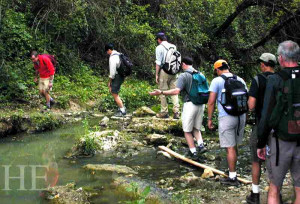
A vital travel route, known as the Via Francigena, once ran through Tuscany, connecting Rome to the rest of Europe. San Gimignano profited greatly from its location at a crucial intersection on the Francigena, and even today, portions of our hiking trails overlap this historic byway. Today’s hike is shorter, to allow time to explore the streets of San Gimignano after lunch. In the morning, we’ll hike out past vineyards of white Vernaccia and red Sangiovese grapes, through silvery olive orchards, and alongside a field or two of sunflowers. A raptor glides overhead as we walk past a small abandoned church, and its overgrown cemetery. At each break in the trees, the towering skyline of San Gimignano reappears.
Lunch is an elegant affair at an agriturismo, followed by a tour of the vineyard and facilities. In the afternoon, those interested can join us for a walking tour of San Gimignano, whose stone walls ring with history: Macchiavelli once spent time here, and the 12th-century church still displays frescoes from the life of Christ. The ramparts protecting the town date back eight centuries; we can stand on these ancient ramparts and look out over the red roofs and green countryside. Further dramatic panoramas await those who climb the 200 steps of the Torre Grossa, the only tower open to the public.
There’s time this afternoon to investigate San Gimignano’s varied museums, too: One devoted to the Etruscans; another to the art of the medieval and early Renaissance periods, in which one particular painting raises speculation: Are that two men in that tub? And then there’s the Museum of Torture, which avoids sensationalism, yet is every bit as graphic as the name implies. Back on the terrace that we now call home, relax under a chestnut tree, as a landscape of orchards, coppices, and vineyards stretches out before you. This calls for a glass of Chianti Classico!
Day 6: Chianti Classico Country
Today we move to a new location, the picturesque Castelvecchi (no relation to Castelvecchio, the ruins we recently visited), on the outskirts of Radda in Chianti. We’ll travel by van as far as Castellina in Chianti, also dating to the Etruscan era, but better known today as a producer of Chianti Classico wines. We’ll have time to climb up the 15th-century castle and to walk the town’s ancient streets, including the long Via Delle Volte, a street entirely enclosed in stone vaulting, with occasional windows to illuminate the passageway.
Then we begin today’s hike. First stop: a hill just outside the town known as Montecalvario. This hill is not a natural geographic feature, but an enormous burial mound, built by the Etruscans in the 4th century B.C. The sides of the mound are marked by four entrances, at the four points of the compass, leading us down stone passageways to the ancient underground burial chambers. Much of today’s walk will be along a little-traveled, unpaved road taking us east, toward Radda. Some of the soil here is too poor, or too hilly, to cultivate, and we pass many patches of macchia — scrub brush with a mix of bramble and broom, occasionally perfumed with mint, sage, and wild rosemary.
Nearing Radda, we’ll detour briefly to the village of San Giusto in Salcio, where an 11th-century church rests on the site of an Etruscan temple. Then we reach the outskirts of Radda in Chianti, and a welcome sight on a hot day: a small lake with an even smaller beach.
Finally, sit down at the dinner table, with wine produced right here at Castelvecchi. But however much of an appetite you’ve worked up, don’t eat all the bread before the food arrives!
Day 7: The Black Rooster
In the 13th century, threatened by Siena, the towns of Radda, Castellina, and nearby Gaiole formed the Chianti League. They adopted a black rooster (Gallo Nero) as their emblem. Radda in Chianti was, for a time, the capital of this League. Today it remains a center of the Chianti Classico wine region, and the black rooster is its official emblem. Today we’ll walk from Castelvecchi, through vineyards of the Sangiovese grapes that are the basis of Chianti wines, past a 12th-century church, and on through the forest, to this history-filled city.
Some in our group may want to spend an afternoon in Radda’s town center, enjoying the panoramic views, tasting wines, and visiting the shops. Others can continue on to Badia a Coltibuono, a Romanesque Abbey built in the 11th century, before returning home.
Tuscan cuisine centers around simple, fresh flavors. Yet they never let that good bread go to waste. Yesterday’s leftover bread may reappear today in one of several traditional dishes: Ribollita, a comforting soup of beans and vegetables, thickened with bread; bruschetta, spread with fresh tomatoes; or Panzanella, a salad in which the bread is mixed with olive oil, juicy tomatoes, cucumbers, parsley, and basil.
Day 8: A Medieval Town and a Modern Winemaker
Despite all those vineyards, Tuscany is the most heavily forested region of Italy. Today we’ll walk through some of that forest, past bramble and blackberry bushes, along a country road lined with cypress trees, to the fortified medieval town of Volpaia.
The name Volpaia derives from the word for fox, and indeed, fox still lives in these woods, though we’re unlikely to see the shy creature. But the village itself is a fascinating destination, a classic and well-preserved medieval site. Parts of the original walls still stand, as do two of Volpaia’s six towers, high above cobblestoned streets and golden-stone homes huddled harmoniously on the hillside. Grapes hanging out to dry for vin santo decorate a few windows, and the air is redolent with the harvest.
Just as it was 500 years ago, Volpaia today is known for its fine wines and olive oils. Hidden behind the walls of one old building is a modern winery, producing some of Chianti’s best. We’ll visit this winery, learn something about the profession that is the backbone of Chianti Classico country, then sample the goods over a leisurely lunch.
That still leaves time to take the shortest path home, followed by a swim in our pool, or in the lake at the bottom of the hill. Or take a longer route, getting the most from the last full day of hiking, before we see what the chef has planned for us tonight.
Day 9: Departure
Our 8-day week comes to an end this morning. We’ll get you to the station in Radda, where you can catch a bus to Siena or Florence, or arrange travel to Florence, arriving by noon. Often, if several people want to travel to the same destination, they find it easier and relatively inexpensive to share a cab.
If you’ve got extra vacation time to spend in Italy, we suggest you save it for after the trip, rather than before: Chances are, others from this week’s hiking adventure will welcome company as they explore the culture and gay life in Florence, Rome, Siena, or Venice.
Price Includes
Price includes: 1 night in Florence and 7 nights lodging in two smaller towns; Breakfast every day, dinner on 6 days, and lunch on 4 days; Professional HE Travel tour director; Welcome packet with map; A wine tasting, highlighting a variety of Italian vintages; An olive oil tasting, highlighting a variety of Italian oils; Transfers via private bus or public transportation from Florence to San Gimignano on Day 2; from San Gimignano to Radda on Day 6; and to the Florence train station at the end of the trip, arriving by noon. HE Travel provides complimentary Medical & Evacuation Insurance for every US Resident on our group tours who does not have other coverage.
Not included: Transportation to and from Italy; Transfer to hotel in Florence at start of the trip; Transportation from Florence to your next destination at end of trip; 2 dinners, 3 lunches; Snacks and souvenirs; Gratuities for guides; Please note that it is difficult to make early flights on the last official day of the tour, so it is most convenient if you plan one more night in Italy, closer to your airport for your flight home.
Optional Tour Choices:
$900 Single Supplement (for solo travelers who wish to enjoy a private bedroom and bathroom)
Extensions
Stay Longer for a Cycling Tour in Italy at our Puglia Villa
Spend a week cycling along ancient Roman lanes, coastal drives, and mountain paths. Each night, relax at an authentic gay owned and operated agriturismo, enjoying a glass of wine from the villa’s vineyards, gourmet meals, and a dip in the pool, with cute locals always stopping by to enjoy the festivities. Read a personal account of this tour on our Gay Travel Blog.
When you travel on two trips Back-to-Back, you’re eligible for a discount. Contact us for details!
Tour Insurance
We strongly recommend the purchase of Trip Cancellation and Interruption insurance to protect your vacation investment in case of unforeseen circumstances such as flight delay, illness, or injury. Click Here to learn more about our Insurance partner.

